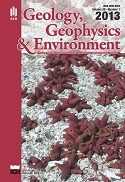Determining rock pore space using image processing methods
DOI:
https://doi.org/10.7494/geol.2013.39.1.45Keywords:
porosity, image analysis, mathematical morphologyAbstract
This paper presents the possibilities of using image processing for determining effective porosity in carbonate and terrigenous rocks. For the purpose of the research, an algorithm was created, which automatically determines the percentage of pore space, based on the analysis of video sequences registered with the use of a microscope. Up to this point stereological research used for describing rock porosity was conducted manually, which is both troublesome and time consuming. The proposed algorithm uses a series of transformation operations such as: non-context operations, contextual operations and morphological transformations. The presented algorithm was tested on video sequences of thin sections of carbonates from Buszewo and Kościan, and sandstones from Dobrzyca and Solec. The obtained results show, that the method of automatic video sequence analysis used for detection and measurement of porosity leads to satisfying results.Downloads
References
Ghiasi-Freeza J., Soleimanpourb I., Kadkhodaie-Ilkhchic A., Ziaiia M., Sedighid M. & Hatampoure A., 2012. Semi-automated porosity identification from thin section images using image analysis and intelligent discriminant classifiers. Computers & Geosciences, 45, 36-45.
Leśniak G. & Such P., 1999. Analiza przestrzeni porowej skał zbiornikowych czerwonego spągowca z południowej części niecki poznańskiej przy zastosowaniu komputerowej analizy obrazu i modeli perkolalacyjnych. Przegląd Geologiczny, 47, 5, 84-85.
Miriello D. & Crisci G.M., 2006. Image analysis and flatbed scanners. A visual procedure in order to study the macro-porosity of the archaeological and historical mortars. Journal of Cultural Heritage, 1, 3, 186-192.
Młynarczuk M., Ratajczak T. & Szydłak T., 2005. Possible replacing traditional rock porosi-tymeasurements by rock image analysis. Polskie Towarzystwo Mineralogiczne. Prace. Specjalne, 27, 37-49.
Ratajczak T., Magiera J., Skowroński A. & Tumidajski T., 1998. Ilościowa analiza mikro¬skopowa skał. Skrypty Uczelniane AGH nr 1534, Wydawnictwa AGH, Kraków.
Rudnicki Z., 2010. Metody komputerowej analizy obrazów w badaniach tribologicznych. Wydawnictwa AGH, Kraków.
Serra J., 1982. Image Analysis and Mathematical Morphology. Academic Press.
Tadeusiewicz R. & Korohoda P., 1997. Komputerowa analiza i przetwarzanie obrazów. Wydawnictwo Fundacji Postępu Telekomunikacji, Kraków.
Wojnar L. & Majorek M., 1994. Komputerowa analiza obrazu. Wyd. Fotobit Design, Kraków.
Downloads
Published
Issue
Section
License
Authors have full copyright and property rights to their work. Their copyrights to store the work, duplicate it in printing (as well as in the form of a digital CD recording), to make it available in the digital form, on the Internet and putting into circulation multiplied copies of the work worldwide are unlimited.
The content of the journal is freely available according to the Creative Commons License Attribution 4.0 International (CC BY 4.0)










